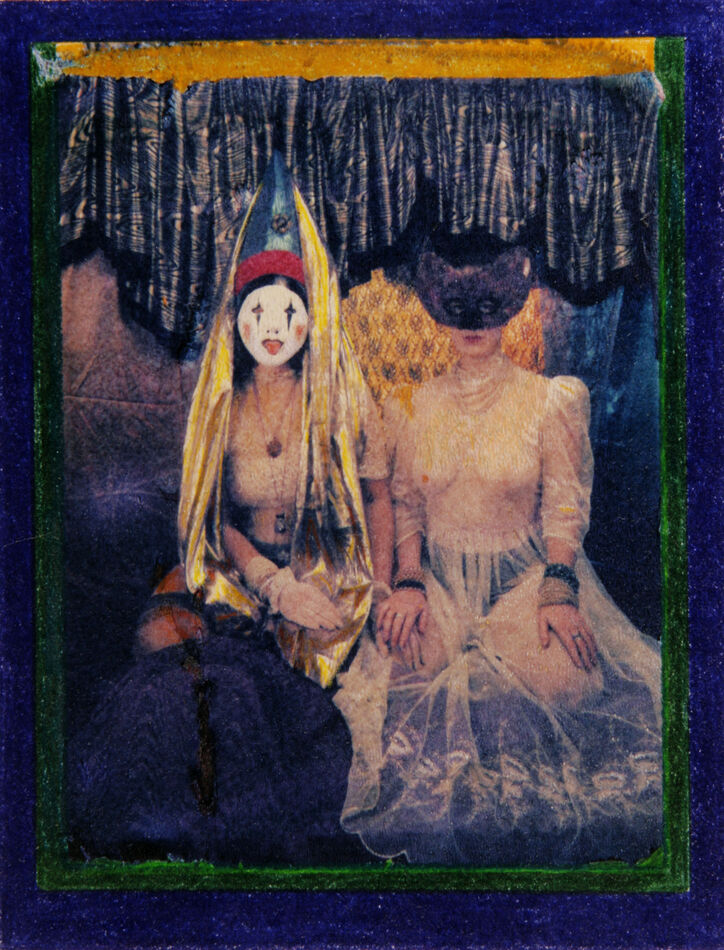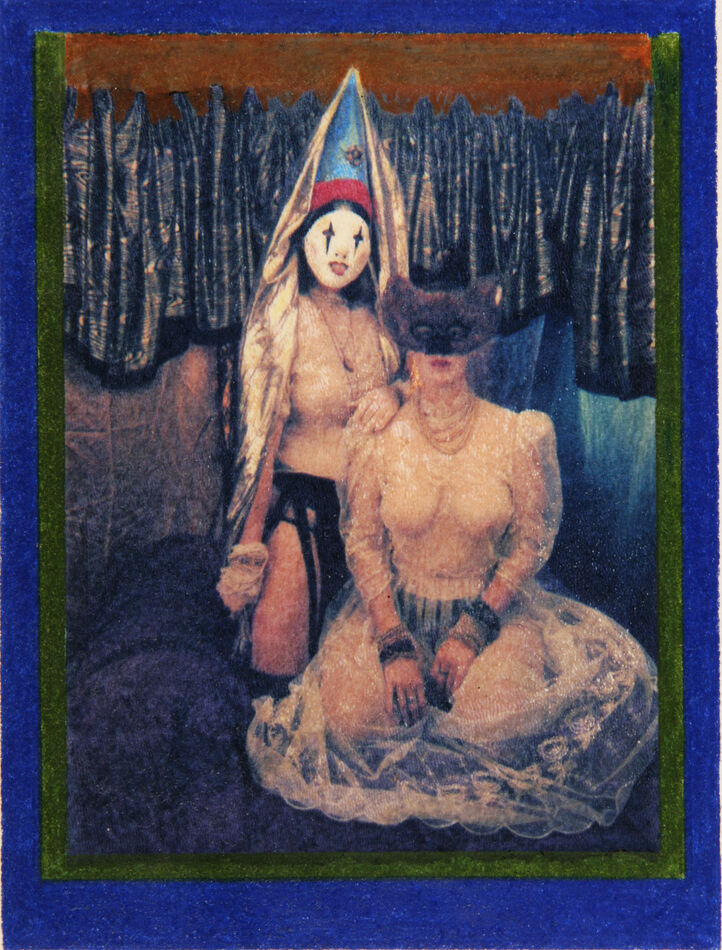Check out Video for DSLR and Point and Shoot Cameras section of our forum.
Angela Polaroid Transfers.
Nov 21, 2023 11:21:15 #
Timmers
Loc: San Antonio Texas.
8X10 Polaroid transfers on rag fine art paper. Hand coloring was added after the transfer session.
Nov 22, 2023 06:58:18 #
Timmers wrote:
8X10 Polaroid transfers on rag fine art paper. Hand coloring was added after the transfer session.
A very interesting set. I would venture to say Gallery worthy. Nice...
Nov 22, 2023 13:54:21 #
Timmers
Loc: San Antonio Texas.
Rich2236 wrote:
A very interesting set. I would venture to say Gallery worthy. Nice...
Odd you should say that, I did several others in the set. A collector purchased one, I donated another to an arts organization and Polaroid when it was still with us had purchased two for their permanent collection. Instead of money, I trade a VP for more 8X10 (809) Polaroid material so I could make more images. I know, but that is what artist do, we "Catch Time, Make Art"!
Check out Sports Photography section of our forum.
Nov 22, 2023 14:59:21 #
Timmers wrote:
Odd you should say that, I did several others in the set. A collector purchased one, I donated another to an arts organization and Polaroid when it was still with us had purchased two for their permanent collection. Instead of money, I trade a VP for more 8X10 (809) Polaroid material so I could make more images. I know, but that is what artist do, we "Catch Time, Make Art"!
I quite agree with trading for more material. I did the same in my time too, but for other art materials. Like you, the money would come later on when I had more product and people got to know my work.
Nov 23, 2023 05:09:16 #
Timmers wrote:
8X10 Polaroid transfers on rag fine art paper. Hand coloring was added after the transfer session.
You always seem to surprise us Tim,
When were these done because the last two has the lady that resembles Vada.
Either way very nice work.
Bruce.
Nov 23, 2023 18:53:36 #
Timmers
Loc: San Antonio Texas.
riderxlx wrote:
You always seem to surprise us Tim,
When were these done because the last two has the lady that resembles Vada.
Either way very nice work.
Bruce.
When were these done because the last two has the lady that resembles Vada.
Either way very nice work.
Bruce.
My Polaroid Transfer work was done before I ad meet VADA. Polaroid was over by 2001. Materials were available till about 2005. I still have some Polaroid equipment. The 4X5 and 8X10 materials are no longer available. Polaroid type Pack size film is still available. Most of the Polaroid materials available today are not to te quality of the older materials.
Polaroid was a typical American corporation that never realized it potential. Like most American companies they never get visionary art people develop their products potential. It really is sad that this is true, but that is one of the great mysteries of the American condition. Part of the problem lies in that they do not know their own history as a great potential. But that is the way that things go.
One of my things was to shoot camera originals, this moved the products of the work into the unique quality of the images being one of a kind originals. I did make some other camera original images using Polaroid materials, but I had really great success making camera originals that were unique one of a kind images. As an example was the AGFA product named "Speed" color print paper. It came in camera sizes (like 8X10) that were extremely simple to use, made as a tungsten sensitivity and so incredible to process that it defied imagination. But like Polaroid, AGFA completely missed the products potential thinking that it should be used to make color enlargements only.
Probably the single best example of blowing a products potential was Ilford Corporation. They created and introduced their B&W printing paper as a variable contrast paper. They allowed their product to be shackled to the idea that the paper could be used with a set of filters to create a paper that could cover multiple contrasts like the older contrast graded B&W papers of the other makers of printing papers.
When in fact they had an original and game changer approach to B&W printing paper. This was because they did not understand the product they had nor how it should be used. Had they looked to an artist with a deeper understanding of photography they would have swept the market and replaced all the other printing papers from the market.
No surprise, the same thing happened with Kodak when they introduced Tabular Grain Technology. Even today the T-Grain B&W films are completely misunderstood and not utilized to their potential.
These sound like boasts but they are not. It goes to the vary heart of the discovery of photography. We are told that photography was 'invented' by Nicephore Niepce and Daguerre around 1826. This is absolute nonsense. Niepce oldest image is housed at the Humanity Research Center of The University of Texas at Austin Texas. BUT, in the same collection are notebooks containing the work of English clergymen who were what science refers to as Natural Scientist. One of these notebooks contains the writings and permanent photographic images of kit glove materials that predates Niepce's oldest images by at least 15 years. There are other examples in the collection, dozens of these examples using light sensate silver salts all perfectly preserved. Also, keep clearly in mind that Niepce made his image by a material referred to as Bitman of Judea. What was this material? There are three versions of this material, the one Niepce used was a refined product, there is another used by print makers as an opaque material to keep a copper plate from interacting with the acid in an etching bath. The third and most crude version is the material we cover roads with, asphalt. (Yes, it starts out black and as it ages it turns a lighter shade to almost white. If you cover a road way with an opaque material for a year or two you will have created basically a stencil that will last for years as the two are age at different rates).
In the end what are we left with? That photography is to important to leave to dead heads and academics. They are ill-equipped to understand the subject of photography. So, proof of this statement is needed. Back to the photographic collection we go. At the research center there are examples of a printing process called Cyanotype. There one will discover prints by the process Cyanotype of vary old pinhole images done by armatures. Yet these negative for those prints can be found in the archive. BUT, no modern print by the Cyanotype process can be pulled using modern Cyanotype processes. A close second can be gotten by printing the original negatives by either Platinum or palladium printing. Even with modern (which no one in the 1850-0s possessed) digital and masking negatives can we reproduce these ancient prints in the archives. Still, there must be something that the old guys did that made this printing possible. Research of all the existing literature reveals nothing of any indication as to what can be a clue to what is a solution to this reality.
My conclusion was simple, there are massive problems with how we approach photography, what's history is and just how photography must be changed to make right these problems corrected. The vary potential and future of photography is at risk.
The solution is obvious. First, a solution to the problem of the Cyanotype process is needed. The answer is that everything we know about the Cyanotype process must be wrong, so it is simple, through out all the literature about Cyanotype, it is wrong and needs correcting. The solution to this is simple, something is missing in our understanding of the Cyanotype process. That something is TIME. Before processing and after the print has been exposed one must 'rest' the print for a certain period (18 to 24 hours is the needed rest period). It took me a lazy 20 years to discover this 'secret' to the process.
So how did I discover all this? By being a working photographer, it is why I give myself the title of Master Photographer. It is the bending of the disciplines of an academic background, an understanding of what it means to be truly photographic and final to have good luck and a great desire to understand my discipline. Much like the old school approach that was that of the Renaissance Masters. The MFA is vary helpful but it is not but apart of the solution. A deep understanding of the craft but that is not all of the solution. S deep understanding of the history of photography, but with an eye to sources and the idiocy of those who came before. Finally, the vision to see beyond the 'norm'. Like Newton, one must get a clear view "by standing on the shoulders of giants".
Nov 23, 2023 22:08:10 #
Check out Advice from the Pros section of our forum.
Nov 23, 2023 22:16:40 #
Timmers wrote:
My Polaroid Transfer work was done before I ad mee... (show quote)
Uh, well Tim, that's a helluva an answer but damn good knowledge. You have a history of all of this that I do not how many here could even been through. Thank you for sharing your work and knowledge with us.
Keep it real bro.
Bruce.
If you want to reply, then register here. Registration is free and your account is created instantly, so you can post right away.
Check out Traditional Street and Architectural Photography section of our forum.




